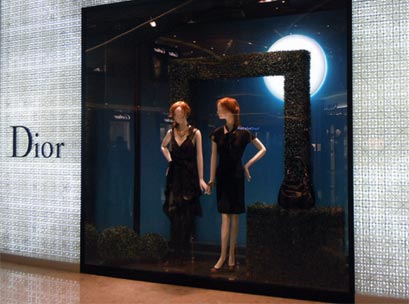Every day more Chinese consumers enter the middle class. How are – and can – western retailers share the new wealth?
The president of Louis Vuitton’s China operations ChristopherZanardi-Landi describes his challenge succinctly: “You have a tsunami ofpeople who are entering into the world of luxury for the first time.
“So you have to find your way to cater to all the different groups of customers as they visit you. That’s the challenge.”
It’s a challenge facing every branded retailer in modern day China.
Granted, the growth initiallycame from a low base as China’s leadership recognised back in 1978 thateconomic reform of its pure communist system was essential for thenation’s future. But few are questioning the country’s ability tocontinue to grow at such a pace in the foreseeable future.
Thegovernment been pursuing ‘programmed urbanisation’ of its largelypeasant population on a scale never seen anywhere else in the world. Sofar it’s moved 500 million into urban cities, driving fierce growth inconstruction and infrastructure. That process still has 20 years and asmany as a further 500 million people left to run.
“This storyhas a long way to go yet, still at a high rate of growth,” says Wright.“What you’ve seen so far is only the beginning.”
The result is a consumer market with rich pickings for retailers – and exporters.
“China is the sort of market where you can sell anything once. It’squite simple to find someone here who will give your product a run. Ifit doesn’t sell, they’ll drop you. They’re very pragmatic,” says Wright.
Rarely in overseas markets can a supplier get such a rapid reaction to the receptivity of a product.
“If you’re successful here, the upside is dramatic.”
Douglas Benjamin, director of Singapore-based luxury brand owner andrights holder FJ Benjamin, is equally bullish about the mainland Chineseopportunity.
“China is going to be a huge part of our retailbusiness in the next few decades. What’s happening in China ismindblowing, but you have to be careful as there are many horror storiesof retailers and brands who have gone into China and lost a lot ofmoney. It’s a very expensive market to commit to and once committed youhave to follow through. You can’t back out and come back in again.”
Back at Louis Vuitton’s elegant new 1200sqm flagship store in the heartof the Pudong financial district, Zanardi-Landi is having littledifficulty keeping China’s newly affluent consumers satisfied.
Inside Retailing has learnt his latest store - the city’s third and oneof two opened in Shanghai on April 28 2010, three days before WorldExpo began - hosts 600 to 800 customers a day and boasts a conversionrate of seven per cent. Few customers would spend less than severalhundred dollars a visit. A huge proportion would spend more than $1000.
Chanel, Fendi, Prada, Dior and many more - all the big names in luxurygoods are in China now and Louis Vuitton is all too well aware it cannotrely on its name along to succeed in a surprisingly discerning - anddemanding - market.
“China has become the battlefield of the luxury industry,” explains Zanardi-Landi.
A small group of brands have been here for a long time and offering consistent standards of stock and service.
Others have been here several years, but not really focused on the market - now they are very focused, he says.
Others are newcomers, some learning harsh lessons for failing toresearch the market properly and meeting Chinese consumers’ increasinglydiscerning choice.
The amount of money spent on luxury goodshas gone vertical in the last two years, but if you’re going to enterthe market, he advises, you have to do it well from the very beginning.
“The barriers to entry are quite high. It’s a market where you comewith a brand - if you take the view of well, I don’t really want toinvest a lot I just want to test the waters, so I’ll have a franchiseeand I’ll build a store and I’ll put it on the first floor of a shoppingcentre and we’ll see how we go - well, you’ll be dead before you start.”

That’s because the Chinese will take notice of the physical strength ofthe brand. You have to be in the best shopping centre, you have to havea prime location and you have to do everything right from the verybeginning.
Chinese consumers have an inbuilt view that everything outside China is better.
“So it doesn’t matter what you build, the view is that it must bebetter outside, particularly when it comes to choice,” saysZanardi-Landi.
Price is not an issue - Chinese luxury goodspurchasers know it is going to be more expensive at home due to importduties and VAT.
“But in terms of choice, they assume that theoffer must be better in Hong Kong and it must be better in Paris. Ittakes a long time to convince consumers that what you’re doing here isas goo d and (the new lines) are coming as quickly and that they havethe same amount of choice they have on the outside.
“Theproblem you have here is that there are a lot of new entrants coming tothe market, constantly reinforcing that misconception.
“They’renot thinking of distribution or quality. They’re often using it as adumping ground for old product. They’re probably investing hardlyanything in training, so the experience is not as good (in China) as itis outside, even though it is new.”
Compounding that is thefact both China’s rich and its middle class are travelling inunprecedented numbers, whether on short stays in the casinos of Macao orSingapore, shopping trips to Hong Kong or travel for business orholidays in Europe. Zanardi-Landi says Louis Vuitton has noticed a hugeincrease in the number of Chinese shopping in Paris - not just in itsown stores, but in its rivals’ too.
“For us, the Louis Vuitton approach has always been the same. We have 460 stores worldwide. We own and
operate them all and we want to make sure we have a very consistentapproach wherever we go. The products you see here are the same asyou’ll see in Paris right now. In fact I dare say you have a slightlywider choice of products here right now because we’re having a worldwidestock shortage.”
The strategy is working, he says, with customer loyalty in the China stores noticeably building.
While Chinese consumers may not necessarily trust foreign brands topresent the same level of choice in China as in markets closer to home,foreign brands have an edge over local names: they’re aspirational bynature because it is a badge of success and sophistication to be seenwearing an off-shore brand.
“I don’t see Chinese luxury brands taking off any time soon because theChinese consumers are concerned about the history and heritage of yourbrands,” explains Anson Bailey, principal, business development, withKPMG’s China consumer division.
“They’re part of the reason people buy a brand.”
He says in time China will compete, but it will take a while for them to resonate with China’s rising middle class.
Offshore brands - both luxury and those of a more mainstream naturelike Nike or Esprit - are well-known amongst their target audience.
“Chinese consumers are very wired. They’re chatting on the internet,browsing the web. We’re already seeing the rise of the sophisticatedconsumer inside China. They’re doing their homework,” says Bailey.
Consumers like those are the ones who’ll be shopping in one ofZanardi-Landi’s store sometime in the next decade, if they’re notalready. Part of that tsunami.
And, yes: Zanardi-Landi concedes having a tsunami of customers is a great problem to have.
“It’s a positive challenge.”
This feature first appeared in Inside Retailing Magazine. Click here to subscribe.






